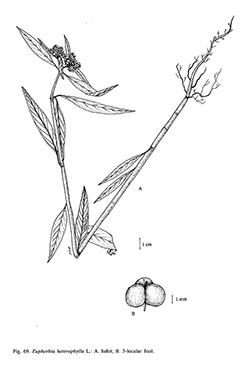e-Flora of Thailand
Volume 8 > Part 1 > Year 2005 > Page 274 > Euphorbiaceae > Euphorbia
7. Euphorbia heterophylla L.wfo-0000962515
Sp. Pl.: 453. 1753; Boiss. in DC., Prodr. 15(2): 72. 1862, p.p.excl. var. cyathophora; Ridl., Fl. Malay Penins. 3: 181. 1924, p.p. excl. E. cyathophora; Gagnep. In Lecomte, Fl. Indo-Chine 5: 244. 1925, p.p. excl. E. cyathophora; Burkill, Dict. Econ. Prod. Malay Pen. 1: 978. 1935; Radcl.-Sm., Kew Bull. 26: 264. 1972, p.p.excl. E. cyathophora; in Fl. Pakistan 172: 112. 1986; P.H.Hô, Câyco Viêtnam 2, 1: 357, pl. 4661. 1992; J.S.Ma, Fl. Reipubl. Popularis Sin. 44(3): 67, pl. 17 fig. 5–8. 1997; I.M.Turner, Gard. Bull. Singapore 51: 99. 1999.— Cyathophora heterophylla (L.) Raf., Fl. Tell. 4: 117. 1838.— Poinsettia heterophylla (L.) Klotzsch & Garcke, Monatsber. K.D.Koenigl. Preuss. Akad. Wiss. Berl. 1859: 253. 1859; R.L.Dressler, Ann. Missouri Bot. Gard, 48: 339. 1961. Fig. 69.
Accepted Name : This is currently accepted.
Synonyms & Citations :
Description : Erect herb, up to 1 m high, stems brown-green, unbranched or with few lateral side-branches or dichotomously branched in upper part. Indumentum distinct to nearly absent, consisting of scattered, weakly erect, pale to 2 mm long. Stipules as indistinct, irregular lobes 0.5–0.8 mm long. Leaves: petioles 1–4 cm long; alternate (opposite when dichotomously branching), glabrous to slightly pubescent, dark green and sometimes reddish-maroon all over, but never with reddish or white base; blades ovate-elliptic or obovate or linear, very rarely panduriform, ca 4–10.5 by 1.1–5 cm, thin, base obtuse to acute with the very base often attenuate, margin entire to subserrate, apex acute to subacuminate; side veins in 12–16 pairs, distinct, not triplinerved. Cyathia ca 10–20 in terminal dichasial clusters, glabrous to pubescent, on peduncles of 1-2 mm. Involucre 2–2.5 mm long; gland solitary, 0.6–0.8 mm wide with circular opening, without appendage; ovary with stigmas of ca 1.25 mm, bifid for ca half length. Fruits with a pedicel of 1.5–4 mm long; schizocarp ca 3–4 mm long, deeply sulcate, glabrous to slightly pubescent. Seeds 1.8–2.5 by 1.8–2 mm, with truncate apex, surface roughly tuberculate, ecarunculate.
Thailand : NORTHERN: Chiang Mai, Phayao, Lamphun, Uttaradit, Tak, Phitsanulok, Kamphaeng Phet; NORTH-EASTERN: Phetchabun, Loei, Nong Khai; EASTERN: Chaiyaphum, Nakhon Ratchasima, Surin, Roi Et, Ubon Ratchathani; SOUTH-WESTERN: Kanchanaburi, Prachuap Khiri Khan; CENTRAL: Lop Buri, Phra Nakhon Si Ayutthaya, Saraburi, Krung Thep Maha Nakhon (Bangkok), Samut Prakan; SOUTH-EASTERN: Prachin Buri, Sa Kaeo, Chon Buri, Rayong, Chanthaburi; PENINSULAR: Surat Thani, Phuket, Phatthalung, Trang, Songkhla.
Distribution : Pantropical weed, originating from the New World (type).
Ecology : Weed of clearings, plantations, roadsides and waste areas, often on very disturbed places, shady or open, often between grasses, margin of swampy, dry evergreen or deciduous forests, on muddy places; sandy soil, granite or dry limestone hills; sea level up to 1,100 m alt. Flowering and fruiting: the whole year through.
Vernacular : Ya yang (หญ้ายาง); ya yang yai (หญ้ายางใหญ่)(Loei); bai tang dok (ใบต่างคอก), luk khoei tai mae yai tham sop (ลูกเขยตายแม่ยายทําศพ)(Central); phak bang yak tang (ผักบางหยักต่าง)(Rayong).

